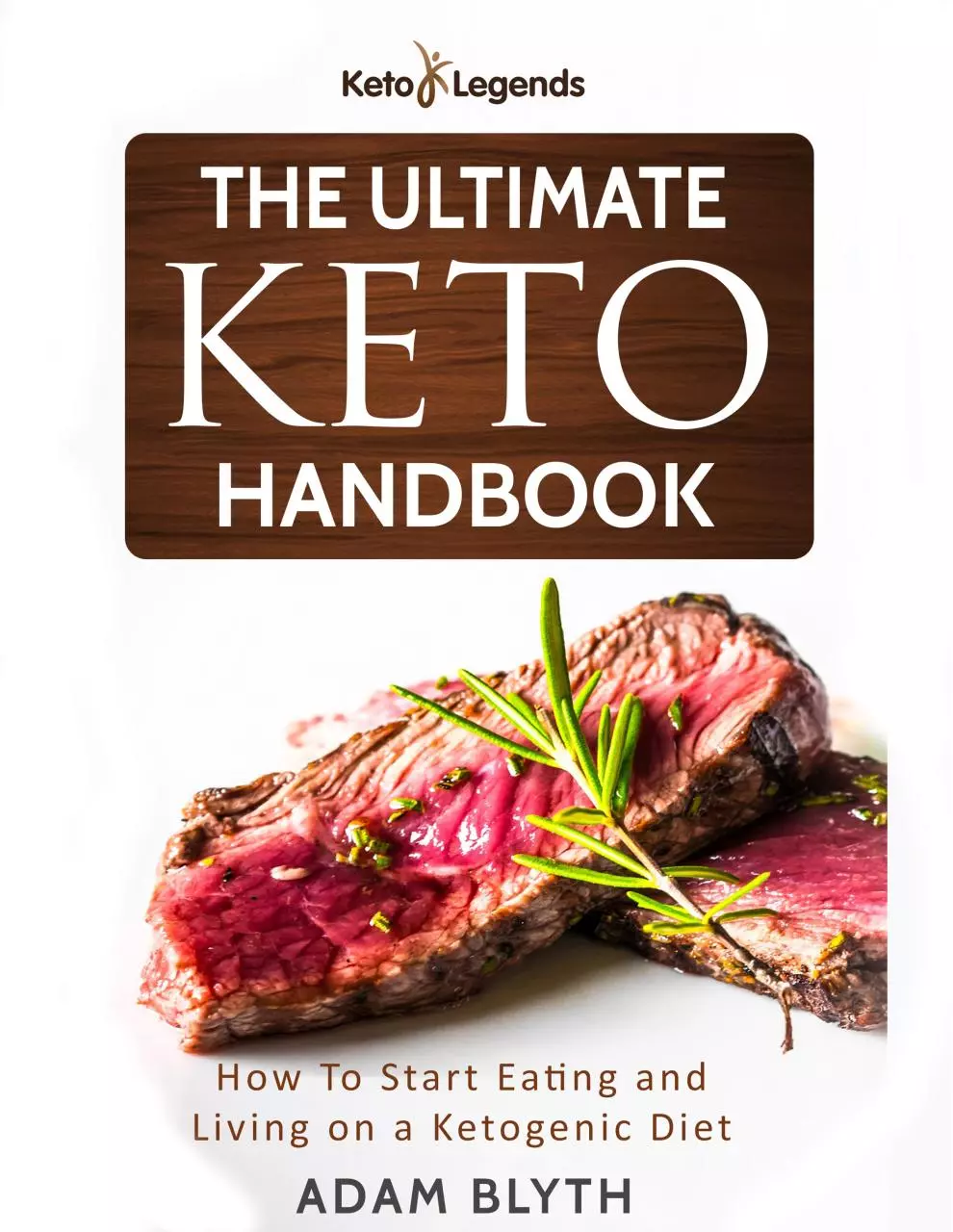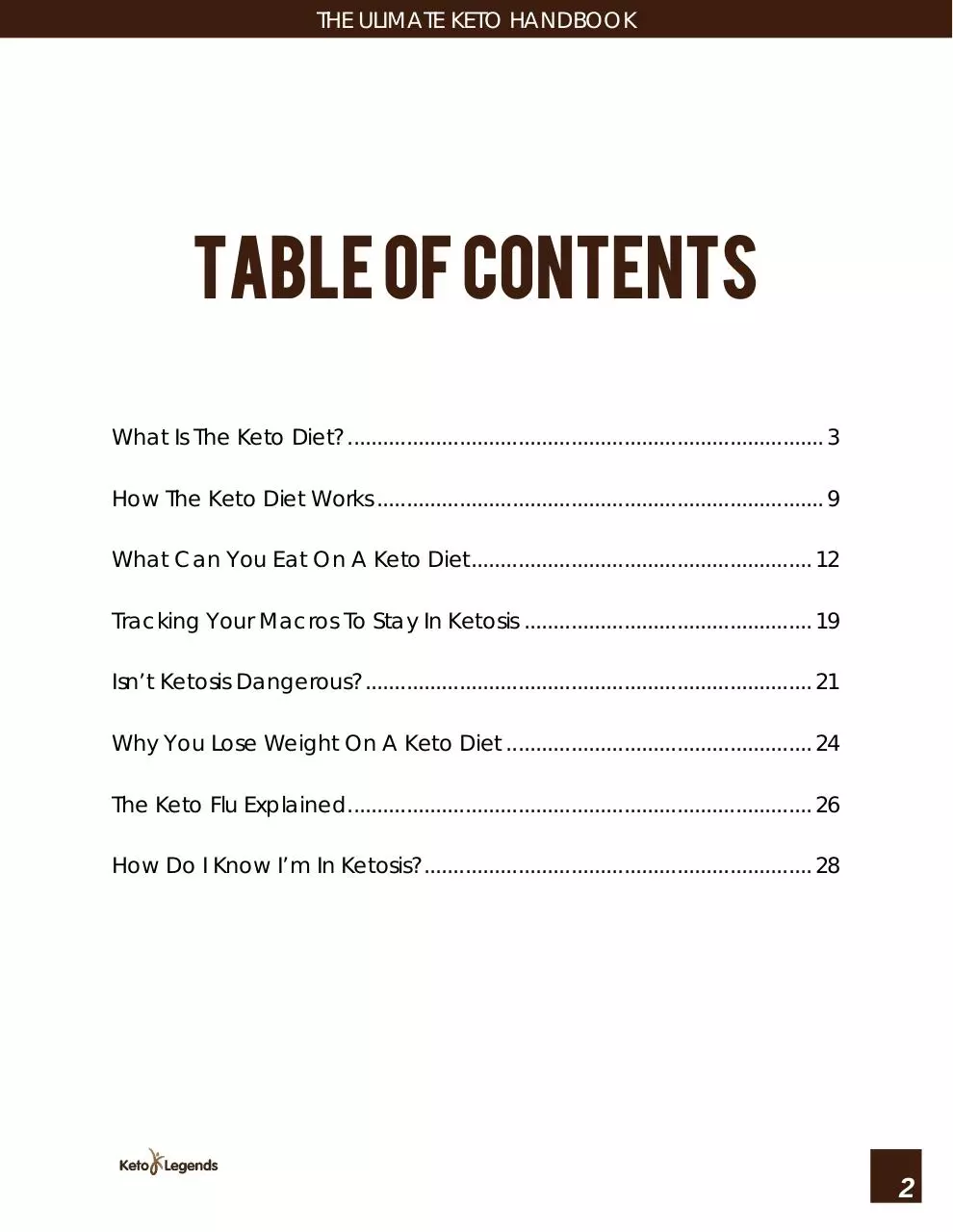KetoLegendsE Book (PDF)
File information
Title: The Ulimate Keto Handbook
Author: Susanne Myers
This PDF 1.6 document has been generated by Acrobat PDFMaker 18 for Word / Adobe PDF Library 15.0, and has been sent on pdf-archive.com on 08/02/2018 at 10:19, from IP address 27.123.x.x.
The current document download page has been viewed 227 times.
File size: 3.29 MB (31 pages).
Privacy: public file





File preview
The Ulimate Keto
Handbook
HOW TO START EATING AND LIVING
ON A KETOGENIC DIET
1
THE ULIMATE KETO HANDBOOK
Table of Contents
What Is The Keto Diet? ................................................................................. 3
How The Keto Diet Works ............................................................................ 9
What Can You Eat On A Keto Diet.......................................................... 12
Tracking Your Macros To Stay In Ketosis ................................................. 19
Isn’t Ketosis Dangerous?............................................................................ 21
Why You Lose Weight On A Keto Diet .................................................... 24
The Keto Flu Explained............................................................................... 26
How Do I Know I’m In Ketosis?.................................................................. 28
2
THE ULIMATE KETO HANDBOOK
What Is The Keto Diet?
T
he Keto Diet (ketogenic diet) is a low-carb, high-fat diet. As a diet plan, it
shares many of the same foods and drinks as the Atkins diet and other low-
carb diets.
What makes a Keto diet different is that it focuses on drastically reducing
carbohydrate intake and replacing those carbohydrates with fat. This drastic
reduction in carbohydrates puts your body into a metabolic state that is called
ketosis.
The point of going into ketosis is to help your body become efficient at burning
fat for energy. While this is happening, your body turns the fat into ketones in the
liver, supplying energy to the brain. A cautionary note: ketogenic diets can
cause massive reductions in blood sugar and insulin levels. So while this can be a
good thing for some people, it can cause problems for other people.
WHY GO KETO?
There are a number of reasons why people go on a ketogenic diet. In most
cases, it is to lose weight. In some cases, they are medically supervised and use
the ketogenic diet as part of a treatment plan.
1. Weight Loss. Due to lowered insulin levels and the body’s ability to burn
stored fat, those who adhere to the diet find that they lose weight more
quickly than with conventional diets.
3
THE ULIMATE KETO HANDBOOK
2. Reduce Medical and Health Problems. Ketogenics is being studied and used
now as a part of the treatment of many different diseases. Studies have
shown that this diet can have benefits for a wide variety of health conditions.
Ailments such as:
•
Heart Disease: In addition to weight loss, the risk factors of body fat, HDL
levels, blood pressure, and blood sugar are improved.
•
Cancer: There are medical studies such as those conducted by the
Department of Radiation Oncology at the Holden Comprehensive Cancer
Center
at
the
University
of
Iowa
and
the
National
Institutes
of
Health’s National Institute of Neurological Disorders and Stroke that are
showing good results with the ketogenic diet being an effective treatment for
several types of cancer and slow tumor growth.
•
Alzheimer’s disease: Ketogenic diets are being used to help treat Alzheimer’s
symptoms. Those patients on the diet have shown a reduction in those
symptoms and improved cognitive function.
•
Epilepsy: The Ketogenic diet is one treatment option for children with
epilepsy whose seizures are not controlled by anti-epileptic drugs. It can help
reduce the number of severity of seizures and can often have positive effects
on behavior.
•
Acne: Lower insulin levels and eating less sugar and processed foods help
improve acne. In addition, an increase in water intake will occur due to the
lack of carbohydrates, offering good hydration of the skin.
4
THE ULIMATE KETO HANDBOOK
3. Lower Cholesterol. A modified ketogenic diet, what might be called a
moderately low-carb diet, is beneficial for healthy adults who are at risk for
metabolic syndrome, those struggling with losing weight or controlling levels
of blood sugar.
As you can see, the ketogenic diet is more than just a low-carb/high-fat diet to
lose weight, the potential of Ketogenics to maximize all aspects of your life is
astounding!
5
THE ULIMATE KETO HANDBOOK
How To Calculate Net Carbs
O
n any low-carb diet, you will be reducing your net carb gram intake.
It is important that you understand how to actually count net carbs.
First, net carbs are simply the grams of total carbohydrates in a
portion of food minus its grams of fiber. Because fiber is a carbohydrate that
your body cannot digest, it does not raise your blood sugar levels or trigger an
insulin response.
Foods that are low in net carbs, which include nutrient-dense vegetables and
fruits, are less likely to interfere with weight loss and do not have a significant
impact on blood sugar.
You can calculate, for yourself, the approximate number of net carb grams in a
low-carb product. First look at the information on the food label:
Total Carbohydrates
minus Dietary Fiber
minus Sugar alcohol
= Net Carbs
For a comprehensive list of Ketogenic food items, please refer to the website
below:
6
THE ULIMATE KETO HANDBOOK
https://www.ketogenic-diet-resource.com/low-carb-food-list.html
Often, the food label will break down carbohydrates into total carbohydrates,
fiber, and sugars.
Total carbohydrates combine all of the carbs and include fiber, sugars, starches,
sugar alcohols, and glycerin. The label will show the amount found per serving
and is measured in grams. They are found in starches, vegetables, fruits, sweets,
and milk.
Dietary fiber is the amount of indigestible or partially digestible bulk from plant
foods like fruits, vegetables, whole grains, oats, nuts, and seeds and is measured
in grams.
Sugar alcohols are found most often in foods labeled “sugar-free,” including
candy, cookies, chewing gums, and soda, but have recently become popular
in packaged health foods. Sugar alcohol gets its name from its molecular
structure, which is a hybrid between a sugar molecule and an alcohol
molecule. Biochemically speaking, sugar alcohols are structurally similar to sugar
but are either poorly digested or poorly metabolized.
Sugar alcohol has grown in popularity as a sugar replacement in foods because
they contain few calories, have a minimal impact on insulin levels, and are safe
for those with diabetes.
7
THE ULIMATE KETO HANDBOOK
Here’s a list of some popular sugar alcohols so you can identify them when you
look at a nutrition label:
•
Erythritol
•
Maltitol
•
Hydrogenated starch hydrolysates
•
Isomalt
•
Lactitol
•
Mannitol
•
Sorbitol
•
Xylitol
8
Download KetoLegendsE-Book
KetoLegendsE-Book.pdf (PDF, 3.29 MB)
Download PDF
Share this file on social networks
Link to this page
Permanent link
Use the permanent link to the download page to share your document on Facebook, Twitter, LinkedIn, or directly with a contact by e-Mail, Messenger, Whatsapp, Line..
Short link
Use the short link to share your document on Twitter or by text message (SMS)
HTML Code
Copy the following HTML code to share your document on a Website or Blog
QR Code to this page

This file has been shared publicly by a user of PDF Archive.
Document ID: 0000731772.